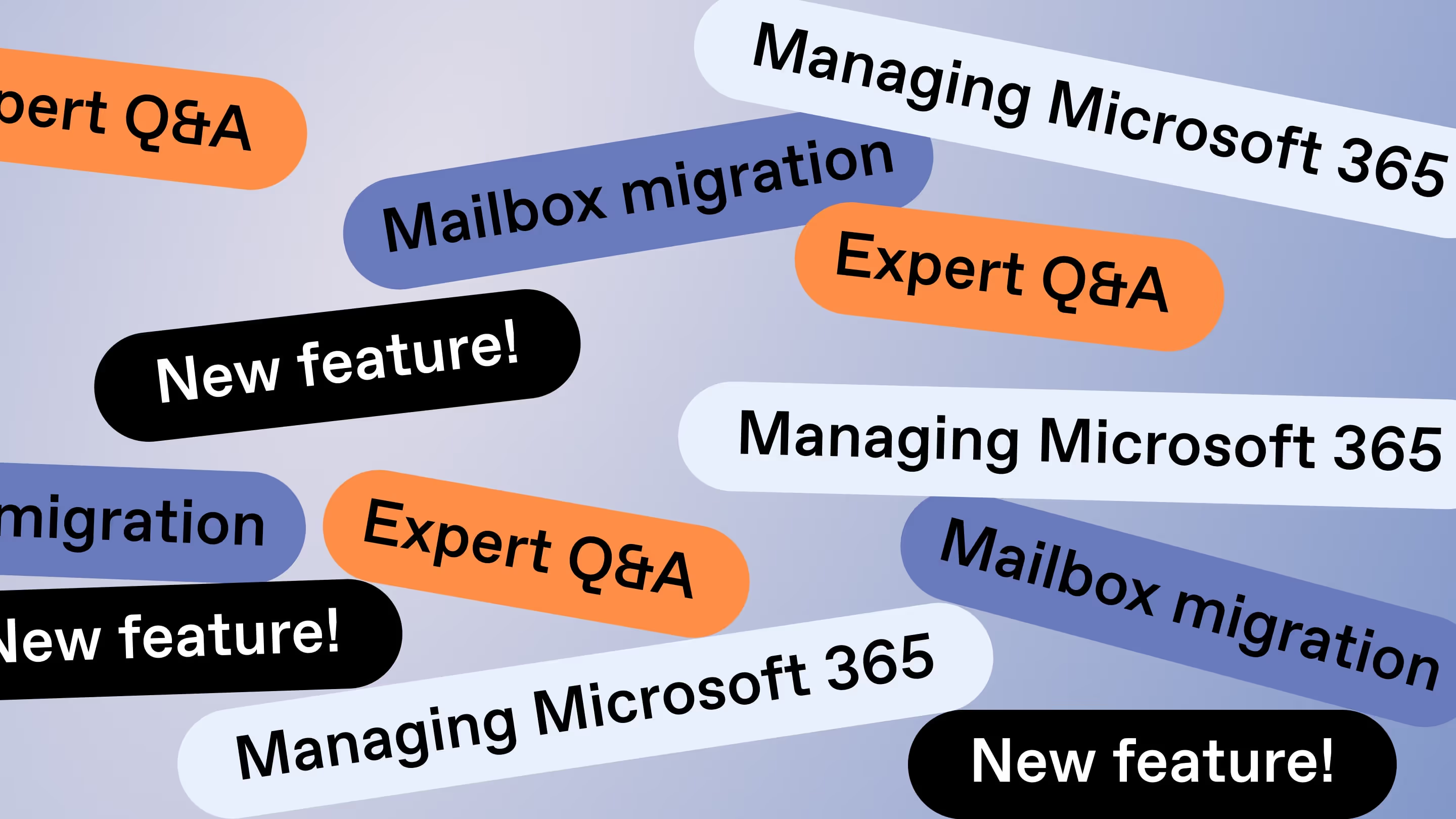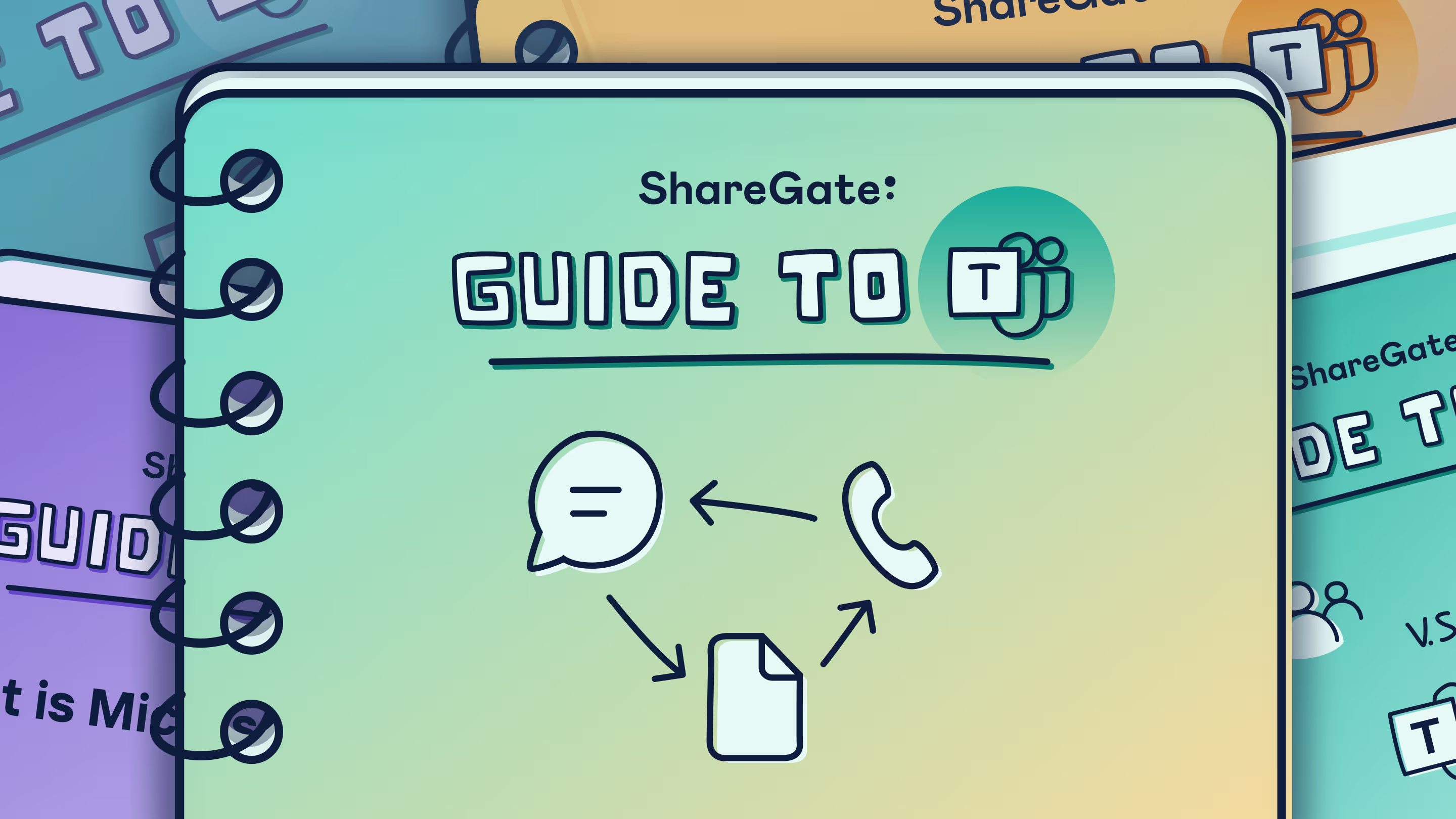[Video] Simplifying Microsoft 365 migrations: Q&A with Microsoft MVP Noorez Khamis

Table of contents
Microsoft 365 migrations can be a headache, right? Thankfully, they don’t have to be! We spoke with Microsoft MVP Noorez Khamis to answer your burning questions and help you navigate your next migration with confidence.
Migrating to Microsoft 365 is a critical project for any IT admin—whether you're preparing for a merger or acquisition, migrating from on-prem to Microsoft 365, or moving Google to Microsoft. But with all the moving parts, it’s easy to get overwhelmed.
That’s why we teamed up with Noorez Khamis, Microsoft MVP and CTO at Creospark, to host a webinar on optimizing your next Microsoft migration.
During that webinar, we had a lot of questions from the audience about how to handle specific Microsoft 365 migration issues that IT pros are dealing with every day. Noorez didn't have a chance to answer them all during the webinar, so we sat down with him face-to-face (or, more accurately, screen-to-screen) to dig into some of the most frequently asked questions.
You can watch or read on for Noorez’s expert advice!
Q: When migrating to SharePoint Online, are there any techniques to first convert the sub-folders to metadata so we don’t have the same endless sub-folder tree hierarchy?
A: When you have a sub-folder hierarchy in your file shares, this just shows that your users have found their own way of classifying and organizing their files so that they can find them easier.
When you are moving to SharePoint Online, this classification and organization can still be done by sub-folders, but now you have more powerful techniques of organizing. These techniques include using Content Types and Columns (or metadata). You can still use sub-folders but ideally with a combination of metadata.
By switching over to these enterprise content management concepts, you are setting yourself up for the future with respect to many aspects.
One such aspect is the ability to create views—you can use views to organize your documents easily by setting your filtering, sorting, grouping, totalling, color coding, etc., and in turn saving these views for later use.
Also, when somebody is searching, not only does search crawl the content of the documents itself but it will also look at the tagged metadata in the column to give you the most relevant result.
In the future, we hope that this metadata may feed Copilot to give better answers to your Copilot-asked questions in your chatbots.
It’s very important that during your analysis of your file shares and folder structure that you come up with a target state Information Architecture—that includes:
- Site collections
- Teams
- Channels
- Content types
- Metadata
- Column types
- Document library configurations
That way, before you are actually performing your migration, the structure is already setup to be easily used with metadata concepts while minimizing that endless sub-folder tree hierarchy to provide a seamless user experience.
There is a big caveat here.
Let’s not fool ourselves that this is a quick and easy process, it probably involves talking to your business unit owners who use those sub-folders and showing them how much easier it could be with metadata.
And on top of this you should also consider the adoption, change management, and end-user Microsoft 365 training initiatives that should also occur.
Q: Our files in our file shares don't have any metadata associated with them, are there ways to automatically tag the appropriate metadata in our libraries when migrating from file shares to SharePoint Online?
A: Well, now that we have our target state Information Architecture created. We probably have hundreds of thousands of folders and files to migrate. We obviously can’t ask people to go in and manually tag all of them, they do have their day jobs and it’s our job as migration experts to support them.
So, there are lots of techniques to tag the data, let’s go through some of them.
ShareGate can add and edit metadata in bulk
First and foremost, as part of the ShareGate stack of features, there is a capability where you can export your source and destination migration data into a spreadsheet (either csv or excel). Using this spreadsheet, you can manually add the metadata in a bulk manner, using the metadata type guides that the ShareGate gives you.
In the case of sub-folders, perhaps there are fomulas you can use to auto-derive the appropriate metadata.
Folder and library column defaults
Next, there is this concept of folder and library column defaults that are built into your document libraries, There are also content type and metadata configurations you should learn to leverage for auto-setting the metadata on your columns.
Create the automations yourself with native Microsoft tools
Another option is creating a Power Automate flow, code, or script or using an Azure Logic App to populate metadata as your documents are added, migrated, or changed, you can also run this population on-demand or on a scheduled basis.
Using SharePoint Premium
One of my favorite options nowadays is using the new features built into SharePoint Premium—not many people know about the advanced SharePoint capability for automatic AI-based metadata extraction and tagging.
One of these features is the ability to drop your documents in a library that already has an extraction model built and the model is already pre-trained to identify the content type and pull in the metadata from the document itself into columns in your library
And my absolute favorite is the Autofill capability. You basically create a new column in your document library and, using natural language, you are describing how you want that metadata populated.
For example, if you need to pull out information that resides in your document perhaps something like the country your product is in. All you need to do is just describe in natural language—something like, "identify all countries referenced in this document and add them as a column," and if no countries are identified, input the sentence “no country identified” in the column and it will automatically do this for you.
Q: Long file paths have been an ongoing challenge during our SharePoint content migrations. Are there any recent developments or solutions to address this issue?
A: If you've optimized your source information architecture—a consistent theme in this webinar and these questions—hopefully you won’t have any long file path issues.
But even with the best laid plans, these may exist and you need to consider it when creating your site, library, folder, and sub-folder structures. Especially when you are syncing your OneDrive and SharePoint or Teams libraries using the OneDrive sync app.
Techniques that help with this would be to first to run pre-migration checks and source file analysis that tools like ShareGate give you to identify candidates for files and folders that may pose problems during the migration. You may need to do some renaming or moving files closer to the root as an interim solution while you are migrating.
Q: If some content is not suitable for SharePoint, should most of these items remain on file shares as a best practice?
A: Well, in the Master your migration webinar, we talked about content that is probably not suitable to be in SharePoint (e.g., Source Code, scripts, Databases, Large Files that change very often that do not have online viewers).
If you don't want to decommission your file shares, sure, leave this kind of content there, it is probably the cheapest in terms of keeping the infrastructure and storage that needs to be there for some other reason.
If you do want to move it to the cloud I would first say, put these files where they belong. As an example, if its source code, perhaps they should be in Github.
Next, let's find out if these files need to be consistently accessed, if not, let's find the cheapest cloud storage to put them in. And you have options here, you have the new Microsoft 365 Archive and Backup capabilities which are cheaper options, and you also have capabilities to use Azure Cloud Document Storage which is quite affordable.
Q: Do you have a recommended tool for content inventory that is simple for business champions to help with planning a migration? We've done several acquisitions and the most difficult part is almost always working with the acquired business to determine where content from the acquired company's tenant will be located in our tenant.
A: Honestly, we love the source file analysis capabilities that are built into ShareGate. This usually arms us with the information that IT needs to figure out what the destination IA needs to encompass.
Now, many times the business can use these same capabilities whether they are using the generated csv and excel files to populate the metadata or the ShareGate tool itself since it is so easy to use.
Q: I am always wary of doing a pre-migration and then a delta migration, as people are cleaning up the source up to the last minute, and the incremental migration will not pick up changes to folder structure or deletion. Do you have any suggestions for this?
A: The week of the migration, I would provide a deadline to your users. After this deadline, all folders and files on your source file shares will stay in that state until they're migrated.
If possible, you can also make your source read-only and change the permissions on the folders to not allow any actions. That will avoid the last second changes before the cut-over date.
Also, tell your end users to keep the files they are actively working on within their OneDrive or local file system folders.
Q: Is there a downside to simply migrating existing file shares in place and then rearchitecting the structure after the fact?
You can do this, and clients have asked us to do this, but the reality is that you will likely not get to the re-architecture in the near future.
People will stay in the habits they are in right now, just replacing one file share with a similar one with a SharePoint interface around it and a little bit of UX tweaks. This means they won't be taking advantage of the productivity and business process automation tools that SharePoint and Microsoft 365 gives them.
For more of Noorez's expert tips, make sure to check out the Master your Microsoft 365 Migrations webinar!
If you have other questions about Microsoft 365 migrations, post it in the comments! Or, if you're already a ShareGate customer, you can join our weekly Ask the Expert webinar to get your questions answered live.
.jpg)


.svg)
%20(1).avif)





.avif)






.jpg)


.png)

